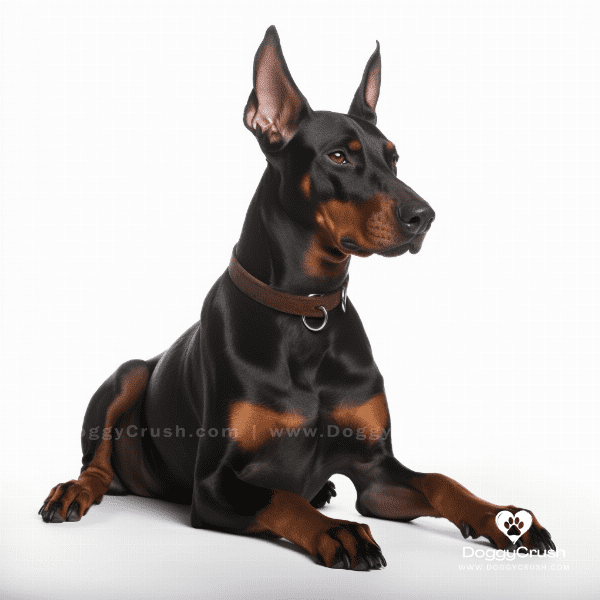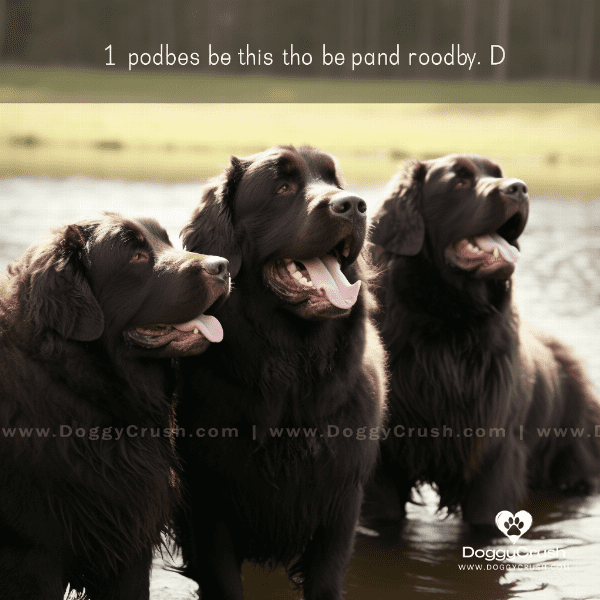Table of Contents
- Introduction to the Doberman Pinscher Breed
- History and Origins of Doberman Pinschers
- Physical Characteristics of Doberman Pinschers
- Temperament and Personality of Doberman Pinschers
- Training and Exercise for Doberman Pinschers
- Health and Wellness of Doberman Pinschers
- Grooming and Maintenance of Doberman Pinschers
- Socializing Doberman Pinschers with People and Other Pets
- Doberman Pinscher as a Working and Service Dog
- Conclusion: Is a Doberman Pinscher Right for You?
Introduction to the Doberman Pinscher Breed
If you’re considering adding a new four-legged friend to your family, the Doberman Pinscher breed may be one that you’re considering. These loyal and energetic dogs have been popular for decades, but there’s more to them than meets the eye. In this section, we’ll explore the Doberman Pinscher breed in more detail, including its history, physical characteristics, and temperament.
History and Origins of Doberman Pinschers
The Doberman Pinscher breed was developed in Germany in the late 1800s by a man named Louis Dobermann, who was a tax collector by trade. He wanted a dog that could protect him during his rounds, and so he set about breeding a dog that would be both fierce and loyal. The resulting breed, the Doberman Pinscher, quickly became popular among police and military units, as well as with families looking for a loyal and protective companion.
Physical Characteristics of Doberman Pinschers
Doberman Pinschers are a medium-to-large breed, with males typically standing between 26 and 28 inches tall and weighing between 75 and 100 pounds, while females are slightly smaller, standing between 24 and 26 inches tall and weighing between 60 and 90 pounds. They have a short, sleek coat that can come in a range of colors, including black, blue, red, and fawn. Their ears are traditionally cropped, though this practice is becoming less common.
Temperament and Personality of Doberman Pinschers
Doberman Pinschers are known for their loyalty and devotion to their families. They are highly intelligent and trainable, and excel in a variety of activities, from obedience and agility to tracking and search and rescue. They are also protective by nature and make excellent guard dogs. However, like any breed, they require socialization and training from a young age to ensure that they are well-behaved and well-adjusted.
Overall, the Doberman Pinscher is a breed with a rich history and a range of admirable qualities. In the following sections, we’ll explore these qualities in more detail, from their physical characteristics to their temperament and training needs.

History and Origins of Doberman Pinschers
The history of the Doberman Pinscher breed is rooted in Germany in the late 19th century. Louis Dobermann, a tax collector in the town of Apolda, sought to create a dog that would be loyal, protective, and fearless. He also wanted a dog that would be a good companion and family pet.
To achieve this goal, Dobermann crossed several breeds, including the German Pinscher, Rottweiler, and the now-extinct Black and Tan Terrier. The result was the Doberman Pinscher, a dog that was both intelligent and versatile, with a strong drive to work and please its owner.
The breed quickly gained popularity in Germany and beyond, with Doberman Pinschers being used by police and military forces as well as by families as loyal companions. In fact, during World War II, the United States Marine Corps used Doberman Pinschers as sentry dogs and messengers, recognizing the breed’s intelligence and loyalty.
Despite their reputation as fierce guard dogs, Doberman Pinschers have also proven themselves to be loving and loyal family pets. With proper socialization and training, they can coexist peacefully with children and other animals.
In the following sections, we’ll explore the physical characteristics and temperament of the Doberman Pinscher breed in more detail.
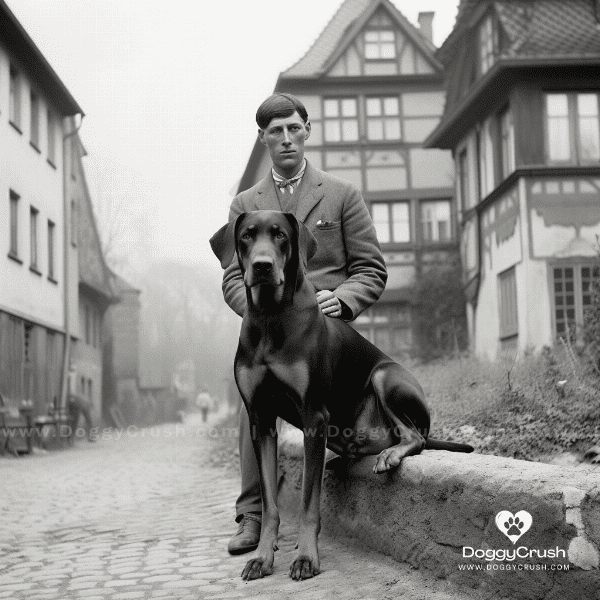
Physical Characteristics of Doberman Pinschers
The Doberman Pinscher is a medium-to-large sized breed that is known for its sleek and muscular build. They are known for their athletic ability, which makes them great for various activities such as running, agility training, and other dog sports.
One of the most notable features of the Doberman Pinscher is its cropped ears. This practice was traditionally done to prevent ear injuries during working activities, but nowadays it is done mainly for aesthetic reasons. However, some countries have banned ear cropping due to animal welfare concerns.
The breed’s coat is short, shiny, and comes in various colors such as black, red, blue, and fawn. They also have distinctive rust markings on their muzzle, chest, legs, and eyebrows.
In terms of size, males typically stand between 26 and 28 inches tall and weigh between 75 and 100 pounds, while females stand between 24 and 26 inches tall and weigh between 60 and 90 pounds. However, it is important to note that individual dogs may vary in size and weight.
Doberman Pinschers are known for their alert and confident stance, with a regal and commanding presence that demands attention. Overall, the physical characteristics of the Doberman Pinscher breed make them an impressive and distinctive breed, which contributes to their popularity among dog enthusiasts.
In the next section, we’ll explore the temperament and personality of the Doberman Pinscher breed, which is just as important to consider as their physical characteristics when deciding whether this breed is right for you.
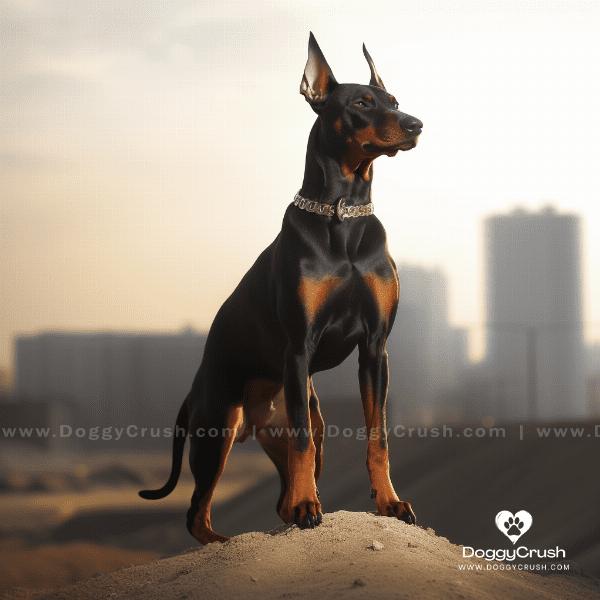
Temperament and Personality of Doberman Pinschers
Doberman Pinschers are known for their loyal, intelligent, and confident temperament. They are often described as fearless and protective, which makes them great guard dogs. However, they are also affectionate and playful, making them great family pets as well.
One of the most important things to consider when it comes to the temperament of a Doberman Pinscher is their socialization. Proper socialization from a young age is crucial to ensure that they develop into well-adjusted dogs. It is also important to note that some Doberman Pinschers may be more reserved or aloof with strangers, which is why early socialization is so important.
As with any breed, training is also essential for a Doberman Pinscher to be a good pet. They are highly intelligent dogs and respond well to positive reinforcement training methods. They are known to excel in obedience, agility, and other dog sports, making them a great choice for active families.
Doberman Pinschers require a lot of exercise and mental stimulation to stay happy and healthy. This includes daily walks, playtime, and training sessions. They are also prone to separation anxiety and can become destructive if left alone for long periods of time.
Overall, the temperament and personality of a Doberman Pinscher make them a great choice for experienced dog owners who are looking for a loyal and intelligent companion. They are great for families with active lifestyles who can provide the exercise and mental stimulation they need to thrive. However, their protective nature means that they may not be the best fit for every family or household.
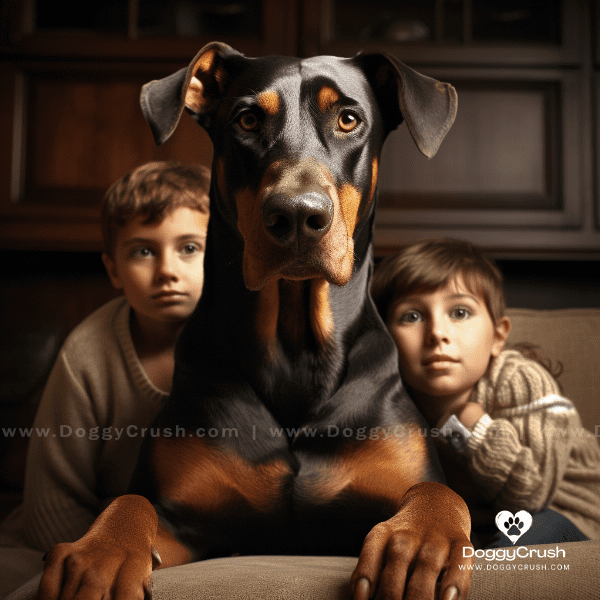
Training and Exercise for Doberman Pinschers
Doberman Pinschers are intelligent and trainable dogs, but they require consistent training and socialization from a young age. Early training is essential to ensure that they grow up to be well-behaved and obedient dogs.
Positive reinforcement training is the most effective method for training a Doberman Pinscher. This includes rewarding good behavior with treats, praise, and affection. Punishing or scolding a Doberman Pinscher can lead to aggression or fear, which can be difficult to overcome.
In addition to training, Doberman Pinschers require a lot of exercise to stay happy and healthy. They are an active breed that requires daily physical activity and mental stimulation. This can include long walks, runs, hikes, and playtime in a secure, fenced area.
Doberman Pinschers also excel in a variety of dog sports, including obedience, agility, and tracking. Engaging in these activities with your Doberman Pinscher can provide mental and physical stimulation while also strengthening the bond between you and your dog.
It’s important to note that Doberman Pinschers are prone to separation anxiety, which can lead to destructive behavior when left alone for long periods of time. Providing them with plenty of exercise and mental stimulation can help prevent separation anxiety and keep them happy and content.
Overall, proper training and exercise are essential for a Doberman Pinscher to be a well-behaved and happy companion. With the right training and care, a Doberman Pinscher can make a loyal and devoted addition to any family.
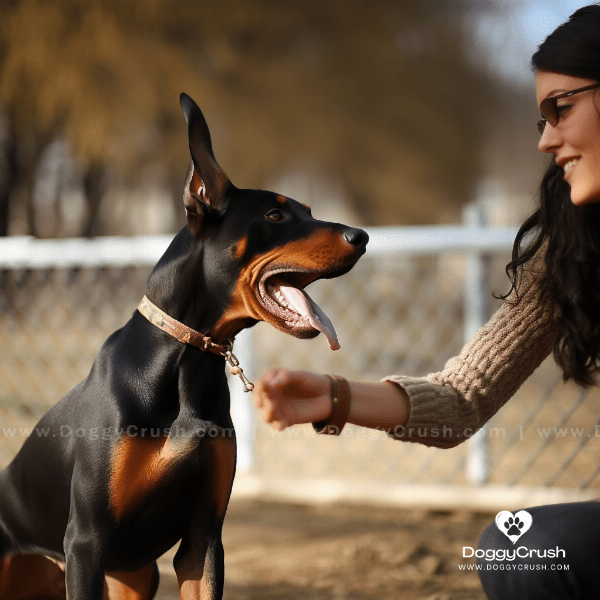
Health and Wellness of Doberman Pinschers
Like all breeds, Doberman Pinschers are susceptible to certain health issues. However, with proper care and attention, many of these issues can be prevented or managed.
Common Health Issues
Some of the most common health issues that affect Doberman Pinschers include hip dysplasia, heart disease, and von Willebrand’s disease, a bleeding disorder. They are also prone to bloat, a life-threatening condition that occurs when the stomach fills with gas and twists. This can be prevented by feeding them smaller, more frequent meals and avoiding exercise immediately after eating.
Doberman Pinschers are also at increased risk for certain types of cancer, including lymphoma, osteosarcoma, and melanoma. Regular veterinary check-ups and early detection are key to managing these types of cancers.
Grooming and Maintenance
Doberman Pinschers have short hair that requires minimal grooming. Weekly brushing is usually sufficient to keep their coat shiny and healthy. They also require regular nail trims, dental cleanings, and ear cleanings to prevent infection.
Diet and Exercise
Proper nutrition is essential for a Doberman Pinscher’s health and wellbeing. They require a high-quality, balanced diet that is appropriate for their age, size, and activity level. Overfeeding can lead to obesity, which can put a strain on their joints and increase the risk of certain health issues.
In addition to proper nutrition, Doberman Pinschers require regular exercise to maintain their physical and mental health. This includes daily walks, playtime, and training sessions.
Regular Veterinary Care
Regular veterinary check-ups are essential for a Doberman Pinscher’s health and wellbeing. Annual wellness exams, vaccinations, and preventive care, such as flea and tick prevention, can help keep them healthy and prevent health issues from developing or worsening.
Overall, with proper care and attention, Doberman Pinschers can live long, healthy lives. It’s important to be aware of the health issues that can affect the breed and take steps to prevent or manage them.
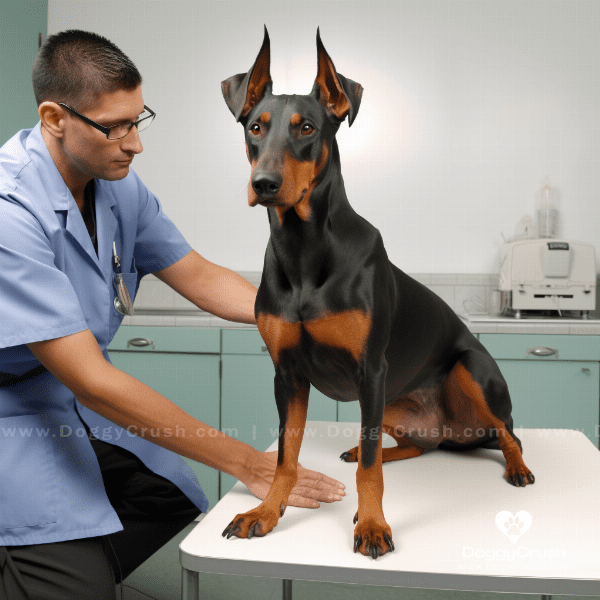
Grooming and Maintenance of Doberman Pinschers
Doberman Pinschers are a low-maintenance breed when it comes to grooming, as their short, sleek coat requires minimal upkeep. However, they do require some basic maintenance to keep them healthy and comfortable.
Coat Care
The Doberman Pinscher’s coat is short and dense, which means that shedding is minimal. Weekly brushing with a soft-bristled brush or rubber curry comb is usually sufficient to remove loose hair and distribute natural oils throughout the coat. They only need a bath when they get dirty or smelly, as over-bathing can strip their coat of its natural oils.
Nail Trimming
Regular nail trimming is important to prevent overgrowth, which can cause discomfort and even lead to mobility issues. Nails should be trimmed every 4-6 weeks, or as needed. It’s important to be careful not to cut the quick, which is the part of the nail that contains blood vessels and nerves.
Dental Care
Doberman Pinschers are prone to dental issues such as tartar buildup, gum disease, and tooth decay. Daily tooth brushing with a soft-bristled toothbrush and dog-friendly toothpaste is the best way to prevent these issues. Regular dental cleanings by a veterinarian are also important to maintain good oral health.
Ear Care
Doberman Pinschers have upright ears, which means that air circulation is good and the risk of ear infections is low. However, they still require regular ear cleaning to prevent wax buildup and infection. This can be done with a damp cotton ball or dog-specific ear cleaning solution.
Other Maintenance
Doberman Pinschers require regular exercise and mental stimulation to keep them healthy and happy. They also require regular veterinary check-ups, vaccinations, and preventive care to maintain their overall health and prevent health issues from developing.
Overall, the maintenance required for a Doberman Pinscher is minimal compared to other breeds. However, regular care and attention are still important to ensure that they stay healthy and comfortable.
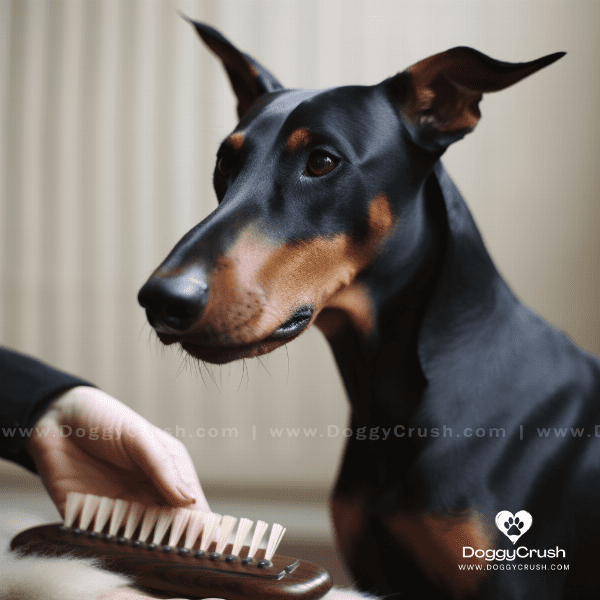
Socializing Doberman Pinschers with People and Other Pets
Socialization is a crucial aspect of owning a Doberman Pinscher. Proper socialization from a young age can help prevent behavior issues and ensure that they are well-adjusted and confident dogs.
Socializing with People
Doberman Pinschers are known for their loyalty and protectiveness, which can make them wary of strangers. Early socialization is important to ensure that they learn to distinguish between friend and foe, and to be comfortable around new people and environments.
Socialization should begin as early as possible and should include exposure to different people of all ages, genders, and ethnicities. It’s important to supervise interactions between children and dogs, and to teach children how to properly interact with dogs.
Socializing with Other Pets
Doberman Pinschers have a strong prey drive, which can make them prone to chasing and potentially harming small animals such as cats or small dogs. Early socialization can help prevent this behavior and teach them to coexist peacefully with other animals.
It’s important to introduce Doberman Pinschers to other pets slowly and under supervision. This can be done by keeping them on a leash and allowing them to sniff and observe the other animal from a safe distance. Treats and positive reinforcement can be used to reward good behavior and encourage positive associations.
Ongoing Socialization
Socialization is an ongoing process that should continue throughout a Doberman Pinscher’s life. Regular exposure to new people, environments, and experiences can help prevent behavior issues and ensure that they are well-adjusted and confident dogs.
In addition to socialization, training is also important for a Doberman Pinscher to be a well-behaved and obedient companion. Positive reinforcement training methods are the most effective for this breed.
Overall, socialization is a crucial aspect of owning a Doberman Pinscher. With proper socialization and training, they can be loving and loyal companions who coexist peacefully with people and other pets.

Doberman Pinscher as a Working and Service Dog
Doberman Pinschers are known for their intelligence, athleticism, and versatility, which makes them well-suited for a variety of working roles.
Working Roles
Doberman Pinschers have been used in a variety of working roles throughout history, including as police and military dogs, search and rescue dogs, and therapy dogs. Their intelligence and trainability make them well-suited for these types of roles.
Doberman Pinschers are also great for dog sports such as obedience, agility, and tracking. Their athleticism and drive to please make them competitive and successful in these areas.
Service Roles
Doberman Pinschers can also make great service dogs for people with disabilities. They are often used as mobility assistance dogs, hearing dogs, and psychiatric service dogs. Their intelligence and loyalty make them great companions for people who require assistance in their daily lives.
As with any working or service dog, proper training is essential for a Doberman Pinscher to be successful in their role. Positive reinforcement training methods are the most effective, and should be tailored to the specific needs of the dog and their intended role.
Finding a Working or Service Doberman Pinscher
If you’re interested in a working or service Doberman Pinscher, it’s important to do your research and find a reputable breeder or organization that specializes in training these types of dogs. Look for a breeder or organization that focuses on breeding and training dogs for specific working or service roles, and has a track record of success in doing so.
Overall, Doberman Pinschers are a versatile and intelligent breed that can excel in a variety of working and service roles. With proper training and socialization, they can be successful and loyal companions who make a positive impact in people’s lives.
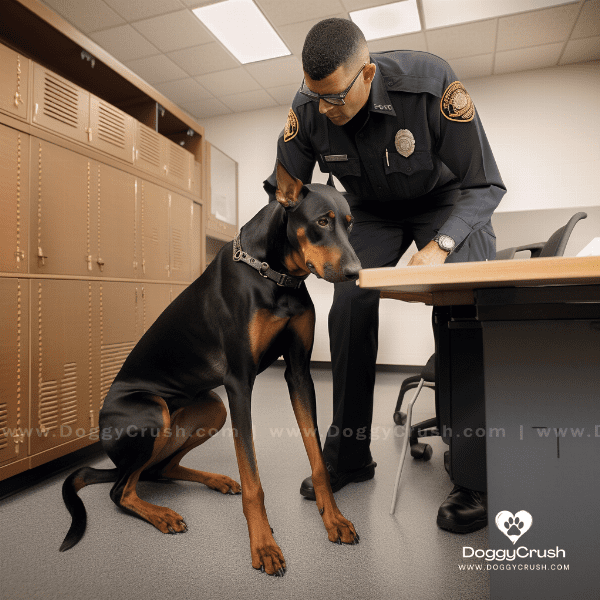
Conclusion: Is a Doberman Pinscher Right for You?
Doberman Pinschers are a unique and versatile breed that can make great companions for the right person or family. However, owning a Doberman Pinscher requires a lot of commitment and responsibility.
Considerations
Before getting a Doberman Pinscher, it’s important to consider the following:
- Do you have the time and energy to provide them with proper exercise and mental stimulation?
- Can you commit to regular training and socialization to prevent behavior issues?
- Are you comfortable with their protective nature and potential for aggression towards strangers?
- Are you prepared for the potential health issues that can affect the breed?
Pros and Cons
Some of the pros of owning a Doberman Pinscher include their loyalty, intelligence, and versatility. They can make great family pets and excel in a variety of working roles. However, some of the cons include their need for regular exercise and mental stimulation, potential for aggression towards strangers, and potential health issues.
Final Thoughts
If you’re considering a Doberman Pinscher as a pet or working companion, it’s important to do your research and carefully consider if they are the right fit for you and your lifestyle. They require a lot of commitment and responsibility, but can make loyal and loving companions for the right person or family.
